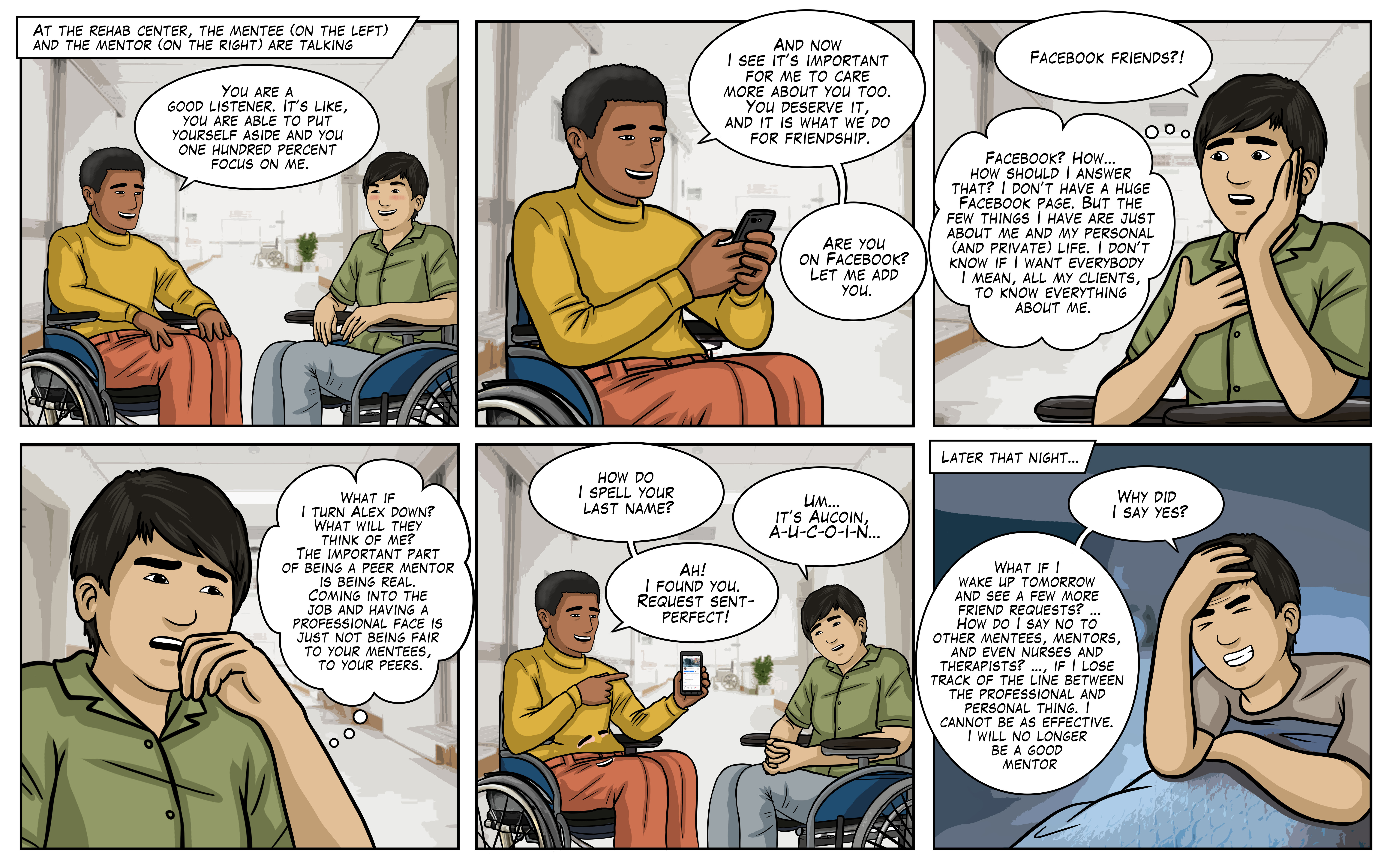Research on mentor well-being
An exploration of the roles and experiences of SCI peer mentors using creative non-fiction
This study presents two monologue stories that represent a snapshot of SCI peer mentors' experiences. The stories highlight the importance of supporting the mental health of mentors to ensure they continue delivering high quality mentorship.
Implications
-
Peer mentors need to be educated on the significance of their role in the rehabilitation process and how their interpersonal behaviours can influence their mentees, both positively and negatively.
-
Peer mentors should receive formalized and accessible training to ensure they are equipped with effective mentoring skills, but also providing them with tools to cope with physical, mental, and emotional stressors they may encounter as mentors.
-
There is a need to continue diversifying and improving the types of services provided to SCI peer mentors in addition to one-on-one counselling, such as interactive educational workshops, for peer mentors to learn and practice coping skills, including mindfulness, meditation, and action-planning.
-
As with other paid employees, SCI peer mentors should be trained to recognize when they are feeling depleted and be supported in seeking appropriate care from a health professional to provide quality psychosocial services to others.
Abstract
Purpose: Spinal cord injury (SCI) peer mentors are individuals who, through their lived experiences, offer emotional support and empathetic understanding to others living with SCI to foster positive health, independence, and well-being. This study explored SCI peer mentors’ perceptions of their roles and experiences.
Materials and methods: Six paid or volunteer peer mentors participated in semi-structured interviews. We first explored the data using thematic narrative analysis to identify patterns, themes, and narrative types. Next, we analyzed the narrative types using creative analytical practices to construct and refine the stories.
Results: Based on our analysis, we developed two stories from a storyteller perspective to present a snapshot of SCI peer mentors’ experiences. The first story focuses on a “discovery” narrative from the point of view of Casey who adopted a person-centered approach to mentoring, focusing their attention on the needs of the mentee. The second story focuses on Taylor’s experiences with the “dark” side of peer mentorship, which focuses on the psychological toll of being a SCI peer mentor, from discussions about suicidal thoughts with clients to struggling with burnout.
Conclusions: Results provided insights for support services regarding the importance of supporting the mental health of mentors to ensure they continue delivering high quality mentorship.
Project Information and Citation
Project lead and contact information: Shane N. Sweet, PhD; shane.sweet [at] mcgill.ca
Citation: Alexander, D., Caron, J. G., Comeau, J., & Sweet, S. N. (2022). An exploration of the roles and experiences of SCI peer mentors using creative non-fiction. Disability and Rehabilitation, 44(22), 6824–6832. https://doi.org/10.1080/09638288.2021.1977395
Creative Nonfiction Approach to Explore Peer Mentorship for Individuals With Spinal Cord Injury
This study presents three dialogue stories that each represents a certain stage of the SCI peer mentorship relationship. The stories reflect the mentorship experiences from both SCI mentors and mentees.
Implications
-
The creative nonfiction stories in this study provided insights into some of the nuances of SCI peer men- torship relationships that are only broadly mentioned in past studies, including mentorship introduction, friendship–mentorship boundaries, and burdens on mentors.
-
To develop and/or optimize SCI peer mentorship programs within rehabilitation, community-based organizations and rehabilitation institutions can consider an informal approach to facilitate mentor–mentee connections, while clearly defining roles and responsibilities for mentors.
-
Because mentors may maintain contacts with mentees beyond rehabilitation settings, organizers of peer mentorship programs need to build support systems to ensure mentors can manage the extra demand.
Abstract
Purpose: Research has examined peer mentorship to understand how it may help people with spinal cord injury (SCI) adapt and thrive. We still lack an in-depth understanding of the perspectives of SCI peer mentors and mentees on their dyadic relationship. This study was to explore the dyadic interactions and relationships between SCI peer mentors and mentees in a peer mentorship program delivered at a rehabilitation center.
Research Method: Between 2016 and 2017, we recruited two dyads of peer mentor and mentee with SCI (N = 4). Each participant completed three one-on-one interviews (N = 12). Data were analyzed using a creative nonfiction approach.
Results: Three unique dialogical stories were developed. Story 1 (A slow and steady start) described how mentors took a mentee-centered approach in building the relationship. Story 2 (Mentorship and friendship: negotiating the “grey zone”) highlighted how mentees and mentors experienced challenges in navigating the boundaries between mentorship and friendship. Story 3 (The “endless” job for mentor) showcased how the relationship could enter a phase in which it could affect mentors’ well-being.
Conclusions: The stories highlighted important attributes to the relationships between SCI mentors and mentees. Considerations were suggested for community-based SCI organizations to integrate peer mentorship into rehabilitation settings, including optimizing mentorship introductions and matching, defining mentors’ role explicitly, and building support systems for mentors.
Comics

Project Information and Citation
Project lead and contact information: Zhiyang Shi, zhiyang.shi [at] mail.mcgill.ca
Citation: Shi, Z., Caron, J. G., Comeau, J., Lepage, P., & Sweet, S. N. (2024). Creative nonfiction approach to explore peer mentorship for individuals with spinal cord injury. Rehabilitation Psychology. Advance online publication. https://doi.org/10.1037/rep0000542

